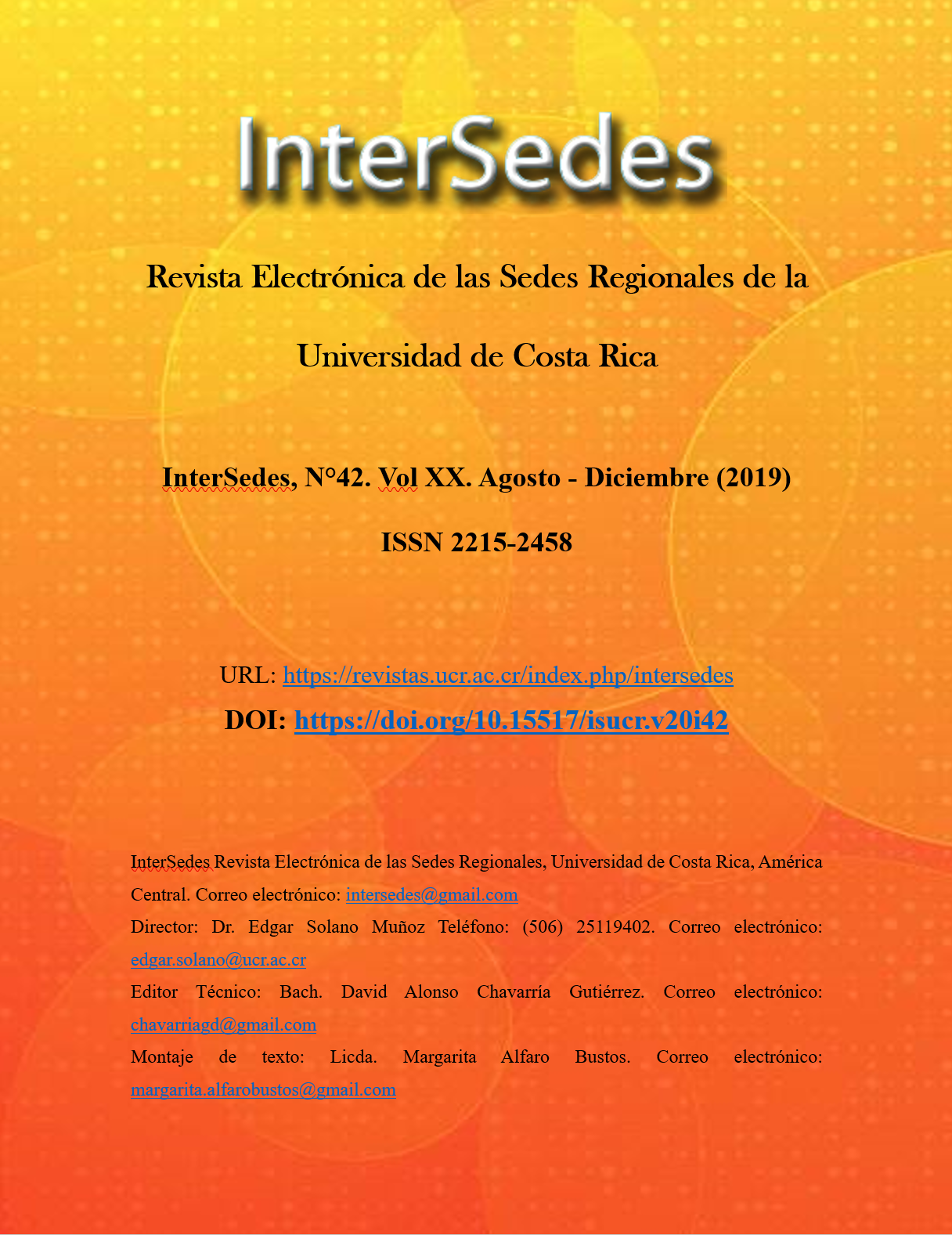Abstract
The phenofases of Blakea scarlatina and its association with biophysical factors were studied, from March 2014 to October 2015. The sample was selected in order of appearance. The phenofases were evaluated every month, with a scale of 0 to four. Budding and leaf abscission occurred during the study, the last one except in June 2014. Flowering occurred in 64% of the research, this makes B. scarlatina an attractive ornamental species. Intraspecific differences were recorded in the phenofases. The leaf abscission and budding were inversely proportional to the temperature. Flowering was associated with temperature, inverse case with relative humidity. Fruiting was associated with precipitation.
References
Almeda, F. 1990.New species and new combinations in Blakea and Topobea (Melastomataceae), with an historical perspective on generic limits in the tribe Blakeae. Proceedings of the California Academy of Sciences Series 4, 46(14): 314.
Almeda, F.2000. A Synopsis of the Genus Blakea (Melastomataceae) in Mexico and Central America. Novon, 10 (4): 299-319.
Azofeifa-Rojas, C. 2015. Album de Especies: Semillas vivas y suelos vivos. Organización para Estudios Tropicales, Estación Las Cruces, San Vito de Coto Brus. Recuperado de: https://ecomaletas.files.wordpress.com/2014/05/albumsemillas-libres_-alta.pdf
Borchert R. 1983. Phenology and control of flowering in tropical trees. Biotropica, 15 (2): 81-89.
Boyle, A. y Bronstein, J.2012. Phenology of tropical understory trees: patterns and correlates. Rev.biol.trop 60 (4). Recuperado de: http://www.scielo.sa.cr/scielo.php?script=sci_arttext&pid=S0034-77442012000400002
Brenes Cambronero, L. 1999. Autoecologia de Elaeagia uxpanapensis D. Lorence (Rubiaceae), en la Reserva Biológica Alberto Manuel Brenes, San Ramón, Costa Rica. Tesis de Maestría. Universidad de Costa Rica, San Pedro de Montes de Oca, San José, Costa Rica. 116 p.
Brenes Cambronero, L. y Di Stefano, J.F. 2001. Comportamiento fenológico del árbol Elaeagia Uxpanapensis (Rubiaceae), en un bosque pluvial premontano de Costa Rica. Rev.biol.trop 49 (3-4): 989-999.
Brenes Cambronero, L. Sánchez, R. 2017. Fenología de Talauma gloriensis Pittier (Magnolaceae), Reserva Biológica Alberto Manuel Brenes, San Ramón, Alajuela, Costa Rica. Revista Pensamiento Actual, Vol 17(Suplemento N°1):11-22.
Cifuentes, L., Moreno, F. y Arango, D.A. 2013. Comportamiento fenológico de Euterpe oleracea (Arecaceae) en bosques inundables del Chocó biogeográfico. Revista Mexicana de Biodiversidad 84: 591-599.
Cortés-Flores, J., Cornejo-Tenorio, G. e Ibarra- Manríquez, G. 2011. Fenología reproductiva de las especies arbóreas de un bosque neotropical. Interciencia 36 (8): 608-613.
Fournier, L. 1974. Un método cuantitativo para la medición de características fenológicas en árboles. Turrialba 24 (4):422-423.
Gómez-Restrepo ML. 2010-2011. Fenología reproductiva de especies forestales nativas presentes en la jurisdicción de CORANTIOQUIA, un paso hacia su conservación. 2 Volúmenes.Medellín: CORANTIOQUIA.
Lieberman D. 1982.Seasonality and phenology in a dry tropical forest in Ghana. Journal of Ecology, 70 (3): 791-806.
Martins, A.B. 2009. Melastomataceae. In: Martins, S.E., Wanderley, M.G.L., Shepherd, G.J., Giulietti, A.M., Melhem, T.S. (eds.) Flora Fanerogâmica do Estado de São Paulo. Instituto de Botânica, São Paulo, vol. 6, pp: 1-168.
Newstrom, L.E., G.W. Frankie, H.G. Baker & R.K. Colwell. 1994. Diversity of long-term flowering patterns at La Selva, p. 142-160. In L.A. McDade, K.S. Bawa, G.S. Hartshorn & H.A. Hespenheide (eds.). La Selva: Ecology and Natural History of a Neotropical Rain Forest. University of Chicago, Chicago, Illinois, USA.
Persy, G., Hahn, S. y San Martín, J. 2014. Estructura y fenología reproductiva de una población remanente de Adesmia bijuga Phil., Fabaceae, en un hábitat costero mediterráneo perturbado de Chile central. Gayana bot. 71 (1) 163-166.
Pérez, C.A., Villalba, J.C. y Almanza, M.I. 2013. Fenología del Roble (Quercus humboldtii Bonpland), en Popayán (Cauca, Colombia). Biotecnología en el Sector Agropecuario y Agroindustrial 2: 145-154.
Primack RB (1987) Relationship among f lowers, fruits and seeds. Annu. Rev. Ecol. Syst.18: 409-430.
Rathcke B, Lacey EP (1985) Phenological patterns of terrestrial plants. Annu. Rev. Ecol. Syst. 16:179-214.
Schwartz MD. 2003. Introduction. En: Schwartz MD, editor. Phenology: an integrative environmental science. Dordrecht: Kluwer Academic Publishers. p. 1-7.
Singh, K. y Kushwaha, C. 2006. Diversity of Flowering and Fruiting Phenology of Trees in a Tropical Deciduous Forest in India. Ann Bot. 97 (2): 265-276.
Vílchez, B., Chazdon, R. y Alvarado, W. 2008. Fenología reproductiva de las especies del dosel en bosques secundarios y primarios de la región Huetar Norte de Costa Rica y su influencia en la regeneración vegetal. Revista Forestal Kurú 5 (15): 1-18


